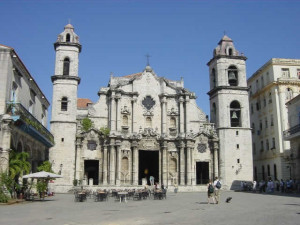News Archives » Central America & the Caribbean
Religious Leaders Support Normalization with Cuba May 4th, 2015
Thirty U.S. religious organizations signed onto a letter to Congress urging an end to the decades-long embargo with Cuba. The Rev. William Antone, U.S. Provincial, signed on for the Missionary Oblates USP. The letter refers to the long-standing ties of many of the faith organizations to religious bodies in Cuba, and cite their call for normalization of relations and an end to the embargo.
Photo credit: Krasivaja at the English language Wikipedia [GFDL (www.gnu.org/copyleft/fdl.html) or CC-BY-SA-3.0 (http://creativecommons.org/licenses/by-sa/3.0/)], via Wikimedia Commons
Engaging for Impact March 2nd, 2015
Why Do Faith-based Shareholders Engage Mining Companies?
The Rev. Seamus Finn, OMI was interviewed recently by SUSTAIN, a publication of the International Finance Corporation, a lending arm of the World Bank that focuses exclusively on the private sector. The IFC is interested in how the Church has engaged in recent years with the extractives industry. Fr. Finn has been centrally involved in high-level meetings called by the Vatican and the Archbishop of Canterbury with mining CEOs and faith-based representatives to discuss ways to increase respect for the rights of, and lessen the impact of mining operations, on local communities. He is Director of Faith-Based Investing for the Oblate International Pastoral (OIP) Investment Trust, and Executive Director of the International Interfaith Investment Group (3iG)
Some of the questions asked in the interview are: “Why should the church care about extractives?”, “Why social justice through investment?”, and “Is there a way to secure societal fairness? Is it always a dynamic or is there a sweet spot?”
Mexican Migrant Children Forgotten at the Border January 22nd, 2015
Border Patrol and Mexican Authorities Fail to Screen and Protect Mexican Migrant Children
Last year, the issue of Central American children fleeing violence made headlines in the United States. But unlike unaccompanied minors from Guatemala, El Salvador, and Honduras, Mexican children fleeing violence rarely get an opportunity to tell their story before an immigration judge. The Washington Office on Latin America (WOLA) has released an investigative video and report on the treatment of unaccompanied Mexican migrant children detained at the U.S.-Mexico border.
Every year, U.S. Border Patrol apprehends approximately 15,000 unaccompanied Mexican children. According to a 2014 report by the United Nations Refugee Agency, nearly 60 percent of unaccompanied Mexican minors surveyed mentioned violence as one reason for leaving home. But in 2013, less than 5 percent were transferred to the U.S. Office of Refugee Resettlement to be screened and later granted an immigration hearing.
Through interviews with migrant children, Border Patrol officials, Mexican authorities, and experts, WOLA’s video “Forgotten at the Border” demonstrates the plight of Mexican children who migrate to the United States in an attempt to escape violence. Unless these children can prove to a Border Patrol agent that they face a credible risk of persecution or trafficking, they are sent right back home.
WOLA’s video highlights the stories of minors like Esteban, a 17-year-old who describes fleeing from a local cartel, crossing the Arizona border, and being deported by Border Patrol. The video is accompanied by an investigative report, as well as recommendations for the U.S. and Mexican governments to better protect and screen unaccompanied Mexican children.
Report: Forgotten on La Frontera: Mexican Children Fleeing Violence Are Rarely Heard
Recommendations: How the U.S. and Mexican Governments Can Better Protect Unaccompanied Mexican Children Fleeing Violence
Interested in following WOLA on social media? You can find them on Twitter @WOLA_org or link to their Facebook page.
Important Advances in Pediatric AIDS Drug Development December 3rd, 2014
 World AIDS Day saw two important announcements regarding development of much-needed pediatric AIDS drugs. This is an issue on which the Oblates and other faith-based investors in the Interfaith Center on Corporate Responsibility (ICCR) have pressed pharmaceutical companies on for years. Since most pediatric AIDS patients are in poor, developing countries, the usual market incentive for drug development does not exist. And, the development of pediatric AIDS drugs, particularly for infants, is challenging. ICCR members have actively encouraged the major pharmaceutical companies to participate in the Medicines Patent Pool, a mechanism established under the auspices of the UN to ‘pool’ patents for drugs to make existing formulations more readily available for generic production and for innovative fixed dose combinations to be developed.
World AIDS Day saw two important announcements regarding development of much-needed pediatric AIDS drugs. This is an issue on which the Oblates and other faith-based investors in the Interfaith Center on Corporate Responsibility (ICCR) have pressed pharmaceutical companies on for years. Since most pediatric AIDS patients are in poor, developing countries, the usual market incentive for drug development does not exist. And, the development of pediatric AIDS drugs, particularly for infants, is challenging. ICCR members have actively encouraged the major pharmaceutical companies to participate in the Medicines Patent Pool, a mechanism established under the auspices of the UN to ‘pool’ patents for drugs to make existing formulations more readily available for generic production and for innovative fixed dose combinations to be developed.
On Monday, World AIDS Day, Abbvie announced a licensing agreement for lopinavir (LPV) and ritonavir (r), top World Health Organization-recommended medicines for children. The license will enable other companies and organizations to re-formulate and manufacture specially designed LPV/r and r pediatric treatments for distribution in low- and middle-income countries where 99% of children with HIV in the developing world live. [Abbvie is a spinoff of Abbott Laboratories that contains the research-based pharmaceutical business.]
On the same day, the HIV Medicines Research Industry Forum announced that the forum is joining PEPFAR, the Global Fund, and the Pediatric HIV Treatment Initiative (PHTI) in the newly established “Global Pediatric Antiretroviral (ARV) Commitment-to-Action” to accelerate innovation and save children’s lives. The initiative is designed to accelerate the development of new, high-priority pediatric ARV co-formulations for first- and second-line treatment by 2017.
Click here to read more »



